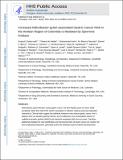| dc.contributor.author | Chaturvedi, R | |
| dc.contributor.author | de Sablet, T | |
| dc.contributor.author | Asim, M | |
| dc.contributor.author | Piazuelo, M B | |
| dc.contributor.author | Barry, D P | |
| dc.contributor.author | Verriere, T G | |
| dc.contributor.author | Sierra, J C | |
| dc.contributor.author | Hardbower, D M | |
| dc.contributor.author | Delgado, A G | |
| dc.contributor.author | Schneider, B G | |
| dc.contributor.author | Israel, D A | |
| dc.contributor.author | Romero-Gallo, J | |
| dc.contributor.author | Nagy, T A | |
| dc.contributor.author | Morgan, D R | |
| dc.contributor.author | Murray-Stewart, T | |
| dc.contributor.author | Bravo, L E | |
| dc.contributor.author | Peek, R M | |
| dc.contributor.author | Woster, P M | |
| dc.contributor.author | Casero, R A | |
| dc.contributor.author | Correa, P | |
| dc.contributor.author | Wilson, K T | |
| dc.contributor.author | Fox, James G | |
| dc.date.accessioned | 2017-03-22T15:57:11Z | |
| dc.date.available | 2017-03-22T15:57:11Z | |
| dc.date.issued | 2014-09 | |
| dc.date.submitted | 2014-07 | |
| dc.identifier.issn | 0950-9232 | |
| dc.identifier.issn | 1476-5594 | |
| dc.identifier.uri | http://hdl.handle.net/1721.1/107643 | |
| dc.description.abstract | Helicobacter pylori infection causes gastric cancer, the third leading cause of cancer death worldwide. More than half of the world’s population is infected, making universal eradication impractical. Clinical trials suggest that antibiotic treatment only reduces gastric cancer risk in patients with non-atrophic gastritis (NAG), and is ineffective once preneoplastic lesions of multifocal atrophic gastritis (MAG) and intestinal metaplasia (IM) have occurred. Therefore, additional strategies for risk stratification and chemoprevention of gastric cancer are needed. We have implicated polyamines, generated by the rate-limiting enzyme ornithine decarboxylase (ODC), in gastric carcinogenesis. During H. pylori infection, the enzyme spermine oxidase (SMOX) is induced, which generates hydrogen peroxide from the catabolism of the polyamine spermine. Herein, we assessed the role of SMOX in the increased gastric cancer risk in Colombia associated with the Andean mountain region when compared with the low-risk region on the Pacific coast. When cocultured with gastric epithelial cells, clinical strains of H. pylori from the high-risk region induced more SMOX expression and oxidative DNA damage, and less apoptosis than low-risk strains. These findings were not attributable to differences in the cytotoxin-associated gene A oncoprotein. Gastric tissues from subjects from the high-risk region exhibited greater levels of SMOX and oxidative DNA damage by immunohistochemistry and flow cytometry, and this occurred in NAG, MAG and IM. In Mongolian gerbils, a prototype colonizing strain from the high-risk region induced more SMOX, DNA damage, dysplasia and adenocarcinoma than a colonizing strain from the low-risk region. Treatment of gerbils with either α-difluoromethylornithine, an inhibitor of ODC, or MDL 72527 (N[superscript 1,]N[superscript 4]-Di(buta-2,3-dien-1-yl)butane-1,4-diamine dihydrochloride), an inhibitor of SMOX, reduced gastric dysplasia and carcinoma, as well as apoptosis-resistant cells with DNA damage. These data indicate that aberrant activation of polyamine-driven oxidative stress is a marker of gastric cancer risk and a target for chemoprevention. | en_US |
| dc.description.sponsorship | National Institutes of Health (U.S.) (Grant P01CA028842) | en_US |
| dc.description.sponsorship | Vanderbilt Digestive Disease Center (Grant P30DK058404) | en_US |
| dc.language.iso | en_US | |
| dc.publisher | Nature Publishing Group | en_US |
| dc.relation.isversionof | http://dx.doi.org/10.1038/onc.2014.273 | en_US |
| dc.rights | Creative Commons Attribution-Noncommercial-Share Alike | en_US |
| dc.rights.uri | http://creativecommons.org/licenses/by-nc-sa/4.0/ | en_US |
| dc.source | PMC | en_US |
| dc.title | Increased Helicobacter pylori-associated gastric cancer risk in the Andean region of Colombia is mediated by spermine oxidase | en_US |
| dc.type | Article | en_US |
| dc.identifier.citation | Chaturvedi, R et al. “Increased Helicobacter Pylori-Associated Gastric Cancer Risk in the Andean Region of Colombia Is Mediated by Spermine Oxidase.” Oncogene 34.26 (2015): 3429–3440. | en_US |
| dc.contributor.department | Massachusetts Institute of Technology. Department of Biological Engineering | en_US |
| dc.contributor.department | Massachusetts Institute of Technology. Division of Comparative Medicine | en_US |
| dc.contributor.mitauthor | Fox, James G | |
| dc.relation.journal | Oncogene | en_US |
| dc.eprint.version | Author's final manuscript | en_US |
| dc.type.uri | http://purl.org/eprint/type/JournalArticle | en_US |
| eprint.status | http://purl.org/eprint/status/PeerReviewed | en_US |
| dspace.orderedauthors | Chaturvedi, R; de Sablet, T; Asim, M; Piazuelo, M B; Barry, D P; Verriere, T G; Sierra, J C; Hardbower, D M; Delgado, A G; Schneider, B G; Israel, D A; Romero-Gallo, J; Nagy, T A; Morgan, D R; Murray-Stewart, T; Bravo, L E; Peek, R M; Fox, J G; Woster, P M; Casero, R A; Correa, P; Wilson, K T | en_US |
| dspace.embargo.terms | N | en_US |
| dc.identifier.orcid | https://orcid.org/0000-0001-9307-6116 | |
| mit.license | OPEN_ACCESS_POLICY | en_US |
